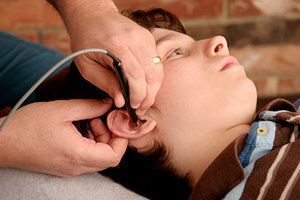One of the longest nerves in the body is known as the vagus nerve (VN). The VN is the 10th pair of cranial nerves that originates at the brain stem in the medulla oblongata. This nerve is part of the parasympathetic nervous system, which is a part of the ANS. Research suggests ear acupuncture can activate the VN.
Major Pediatric Hospital to Offer AOM
One of the more encouraging findings from the recent National Center for Complementary and Alternative Medicine CAM survey (see February issue of Acupuncture Today) was the increase in its use among pediatric patients. Combine this with the trend toward integration into traditional medical settings, and there would seem to be a natural niche where AOM would fit very neatly. We have already seen acupuncture and Oriental medicine making inroads into the armed services, as well as providing unique learning opportunities for medical students. All of this points toward AOM being accepted as a part of the whole health care package. Now, a new collaborative externship program between a prestigious children's hospital and a well-respected AOM school in Los Angeles seems to have found a way to bring these two elements together.
Childrens Hospital Los Angeles, which was ranked among the top 10 pediatric hospitals last year by U.S. News & World Report, and Yo San University have teamed up to provide acupuncture services to patients in the Pain Management Clinic. The services are offered for free, one day a week in the hospital's outpatient clinic. The collaboration, which began in January, offers benefits all the way around; Yo San students get the opportunity to work in a hospital environment, providing pediatric services, clinicians at Childrens Hospital are given an opportunity to see how AOM can help patients, and the patients and their families get the direct benefit of pain relief that acupuncture can provide.

Yo San President Johnathan Heywood, in an interview with Acupuncture Today, explained that while this externship program is starting small, there are hopes of expanding the program later this year. He added that feedback from the students has been extremely positive. "They are absolutely thrilled to be involved with treating pediatric patients. This is also definitely a fantastic opportunity for integrative medicine. It's reaching out to help the East come together with the West."
Heywood mentioned that the program also serves the purpose of fulfilling Yo San's mission statement, which is to educate students to "become exceptional practitioners of Traditional Chinese Medicine and the Taoist healing arts. The school facilitates the development of students' spiritual and professional growth and provides the community with an integrative medical care model and services."
The other half of this story, however, belongs to Jeffrey I. Gold, PhD, Assistant Professor of Anesthesiology and Pediatrics, and director of the Pediatric Pain Management Clinic at Childrens Hospital, whom Heywood credits with having gone through the detailed process of getting the program started. Gold, whose primary specialty is in clinical psychology, has published several papers on CAM methods to reduce pediatric pain, including one review article of acupuncture that concluded, "Given the promising trends in the current research, the relative willingness of families to engage in acupuncture and the low risk of deleterious side effects, acupuncture may serve to harmonize traditional Western medicine and traditional Chinese medicine as a means of promoting preventive care and symptom management for children."1
In an interview with Acupuncture Today, Gold explained that part of what drove him to start the program was that he felt that more needed to be done beyond just drugs and psychotherapy to treat pediatric pain. Although it took a year to launch the program, he was "very tenacious to make sure that it happened." He added that because Childrens Hospital is a teaching hospital affiliated with the Keck School of Medicine of the University of Southern California, the collaboration was very important.
Although Gold was unsure how his colleagues would react when he announced the new program at a faculty meeting on its first day, he admitted to being startled when they all "burst into cheers" and wanted to know when their departments might be able to take advantage of the service. Although the program is currently only affiliated with the pain clinic, there are plans to eventually roll it out to the rest of the hospital.
As for the families and the patients, they are also thrilled with the service. According to Gold, the patients, most of whom are between the ages of 13 and 19, all say that they feel more comfortable and relaxed after receiving the treatments and have been coming back on a regular basis. Gold is collecting data on these patients for further studies.
The students participating in the clinic are equally happy with this opportunity. Gold says that the students are excited to be able to do intakes, diagnose patients and actually learn in real time.
Gold explained that, at least when it comes to treating pediatric pain, "we are not getting to the core of the problem with regular medicine." He likened using acupuncture treatments for these patients to re-setting the nervous system, rather than just treating symptoms, as is done with Western medicine. "It's all about health and wellness," he concluded.
Reference
- Gold JI, Nicolaou CD, Belmont KA, et al. Pediatric acupuncture: a review of clinical research. Evid Based Complement Alternat Med. 2008 Jan 10. [Epub ahead of print].


